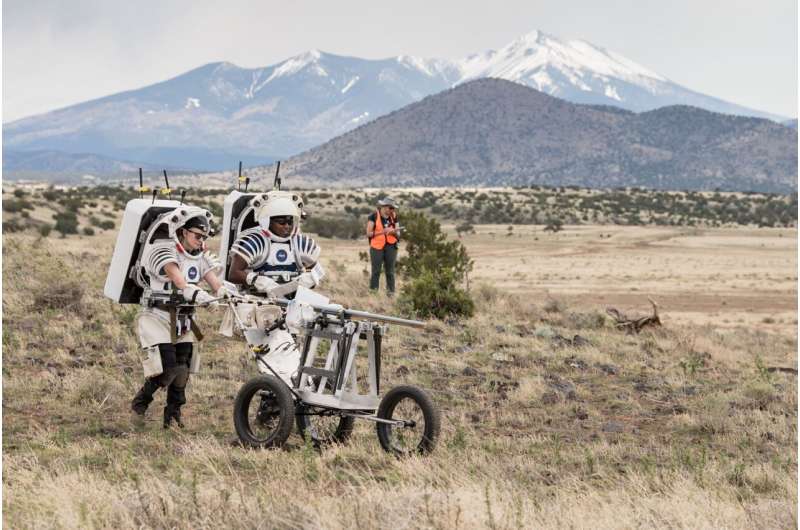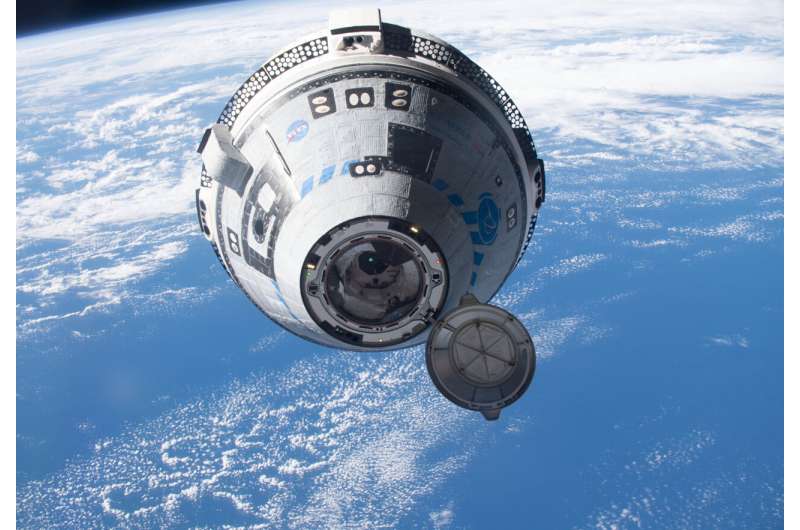Tomorrow.io gets DoD contract to launch two microwave weather sensor satellites
Tuesday, 14 May 2024 21:06

NASA tests technology, practices Artemis moonwalks in Arizona desert
Tuesday, 14 May 2024 19:09
To prepare for exploring the moon during NASA's Artemis campaign, the agency is conducting a week-long field test in the lunar-like landscape of San Francisco Volcanic Field near Flagstaff, Arizona to practice moonwalk scenarios.
NASA astronauts Kate Rubins and Andre Douglas are serving as the crewmembers and wearing mockup spacesuit systems as they traverse through the desert, completing a variety of technology demonstrations, hardware checkouts and Artemis science-related operations.
During the test, two integrated teams will work together as they practice end-to-end lunar operations.
New Method Unravels Slow Electron Behavior
Tuesday, 14 May 2024 18:55 Electrons can exhibit different behaviors based on their energy levels. High-energy or low-energy electron interactions with solid materials trigger various effects. For instance, low-energy electrons can cause cancer but can also be used to treat tumors. They are also critical in microelectronics for producing tiny structures.
Measuring slow electrons is challenging, and understanding the
Electrons can exhibit different behaviors based on their energy levels. High-energy or low-energy electron interactions with solid materials trigger various effects. For instance, low-energy electrons can cause cancer but can also be used to treat tumors. They are also critical in microelectronics for producing tiny structures.
Measuring slow electrons is challenging, and understanding the Dazzling auroras fade from skies as sunspot turns away
Tuesday, 14 May 2024 18:55 The spectacular auroras that danced across the sky in many parts of the world over the weekend are fading, scientists said Monday, as the massive sunspot that caused them turns its ferocious gaze away from Earth.
Since Friday, the most powerful solar storm to strike our planet in more than two decades has lit up night skies with dazzling auroras in the United States, Tasmania, the Bahamas an
The spectacular auroras that danced across the sky in many parts of the world over the weekend are fading, scientists said Monday, as the massive sunspot that caused them turns its ferocious gaze away from Earth.
Since Friday, the most powerful solar storm to strike our planet in more than two decades has lit up night skies with dazzling auroras in the United States, Tasmania, the Bahamas an Terran Orbital Chosen by Lockheed Martin for SDA Satellite Buses Contract
Tuesday, 14 May 2024 18:55First crewed flight of Boeing spacecraft delayed again
Tuesday, 14 May 2024 18:21
The first crewed launch of Boeing's Starliner spaceship to the International Space Station has been postponed again due to a technical snafu, the company said Tuesday.
The next attempt will be May 21 at the earliest.
The high-stakes mission was already called off last week, with two astronauts strapped in and ready to fly.
That was because engineers detected a problem with a valve that regulates liquid oxygen pressure on the Atlas V rocket meant to propel Starliner into orbit.
The valve was replaced and a new launch date of May 17 was set.
But a new problem emerged—a small helium leak in a part of Starliner called the service module, which holds instruments used to control and operate the spacecraft.
Beyond blueprints: DoD’s commercial space strategy leaves industry wanting more
Tuesday, 14 May 2024 14:48
Tracing organic matter origins in Martian sediments
Tuesday, 14 May 2024 13:28 Scientists are investigating Martian sediments to understand early environmental conditions and potential signs of past life. Sediments collected by the Curiosity rover from Gale Crater, an ancient lake formed 3.8 billion years ago, revealed organic matter with a lower carbon-13 isotope content than Earth's, suggesting different formation processes on Mars.
A study in Nature Geoscience on
Scientists are investigating Martian sediments to understand early environmental conditions and potential signs of past life. Sediments collected by the Curiosity rover from Gale Crater, an ancient lake formed 3.8 billion years ago, revealed organic matter with a lower carbon-13 isotope content than Earth's, suggesting different formation processes on Mars.
A study in Nature Geoscience on Catalyzing a Lunar Economy: DARPA's Initial Findings from LunA-10 Study
Tuesday, 14 May 2024 13:28 The expansion of commercial space capabilities has transformed how we deliver mass and services to the Moon. These capabilities could create a real off-Earth economy if they operate jointly. An underlying analytical framework emphasizing integrated models of economic activity is needed to bridge current approaches to lunar system development and an integrated future lunar economy. This framework
The expansion of commercial space capabilities has transformed how we deliver mass and services to the Moon. These capabilities could create a real off-Earth economy if they operate jointly. An underlying analytical framework emphasizing integrated models of economic activity is needed to bridge current approaches to lunar system development and an integrated future lunar economy. This framework World's first high-definition lunar geologic atlas revealed
Tuesday, 14 May 2024 13:28 The first high-definition geologic atlas of the entire Moon, scaled at 1:2.5 million, was unveiled on April 21.
The atlas, available in Chinese and English, consists of the Geologic Atlas of the Lunar Globe and the Map Quadrangles of the Geologic Atlas of the Moon (including explanatory manual). The Geologic Atlas of the Lunar Globe includes the Geologic Map of the Moon, the Lithologic Map
The first high-definition geologic atlas of the entire Moon, scaled at 1:2.5 million, was unveiled on April 21.
The atlas, available in Chinese and English, consists of the Geologic Atlas of the Lunar Globe and the Map Quadrangles of the Geologic Atlas of the Moon (including explanatory manual). The Geologic Atlas of the Lunar Globe includes the Geologic Map of the Moon, the Lithologic Map A new process for the synthesis of rare nuclei in the universe
Tuesday, 14 May 2024 13:28 A new nucleosynthesis process, called the r-Process, has been proposed by scientists from GSI, and the Max Planck Institute for Astrophysics. This r-Process occurs when neutron-rich material is exposed to a high flux of neutrinos. The theoretical proposal, recently published in "Physical Review Letters," may solve the long-standing issue of the production of certain rare isotopes found in the so
A new nucleosynthesis process, called the r-Process, has been proposed by scientists from GSI, and the Max Planck Institute for Astrophysics. This r-Process occurs when neutron-rich material is exposed to a high flux of neutrinos. The theoretical proposal, recently published in "Physical Review Letters," may solve the long-standing issue of the production of certain rare isotopes found in the so SwRI investigates boiling processes in partial gravity
Tuesday, 14 May 2024 13:28 Southwest Research Institute (SwRI) is examining how liquids boil under partial gravity in a series of parabolic flights. This internally funded project, conducted with Texas A and M University, aims to understand boiling on different surfaces in partial gravity, which is crucial for future space missions to the Moon or Mars.
"We have so little data about how boiling works in reduced gravi
Southwest Research Institute (SwRI) is examining how liquids boil under partial gravity in a series of parabolic flights. This internally funded project, conducted with Texas A and M University, aims to understand boiling on different surfaces in partial gravity, which is crucial for future space missions to the Moon or Mars.
"We have so little data about how boiling works in reduced gravi China sends experimental satellite into orbit with Long March 4C rocket
Tuesday, 14 May 2024 13:28 An experimental satellite was launched into space aboard a Long March 4C carrier rocket on Sunday morning from the Jiuquan Satellite Launch Center, situated in the Gobi Desert of northwestern China.
The launch occurred at 7:43 am, with the rocket successfully placing the Shiyan 23 satellite into its predetermined orbits, as stated by China Aerospace Science and Technology Corp, a prominent
An experimental satellite was launched into space aboard a Long March 4C carrier rocket on Sunday morning from the Jiuquan Satellite Launch Center, situated in the Gobi Desert of northwestern China.
The launch occurred at 7:43 am, with the rocket successfully placing the Shiyan 23 satellite into its predetermined orbits, as stated by China Aerospace Science and Technology Corp, a prominent 



